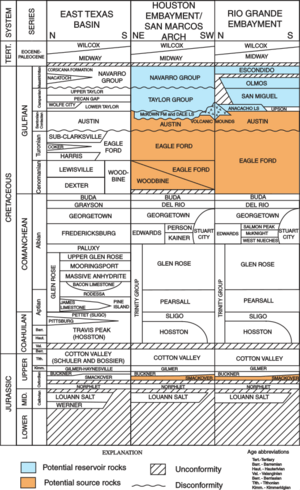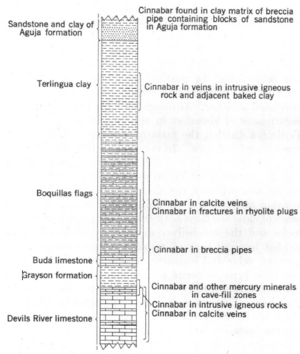Buda Limestone facts for kids
Quick facts for kids Buda LimestoneStratigraphic range: Late Cretaceous (Cenomanian) |
|
|---|---|
| Type | Geological formation |
| Unit of | Washita Group |
| Underlies | Eagle Ford Group, Woodbine Formation, Boquillas Formation |
| Overlies | Del Rio Formation and Grayson Formation |
| Thickness | 100 feet (30 m) |
| Lithology | |
| Primary | Limestone |
| Location | |
| Coordinates | 30°05′06″N 97°51′03″W / 30.0849°N 97.8507°W |
| Region | North America |
| Country | United States |
| Type section | |
| Named for | Buda, Texas |
| Named by | T.W. Vaughan |
| Year defined | 1900 |
The Buda Limestone is a special type of rock layer, also known as a geological formation. You can find it in parts of West Texas and southern New Mexico. This rock layer formed a very long time ago, during the Late Cretaceous period. That's about 100 million years ago! Scientists have found amazing fossils in the Buda Limestone, including bones from flying reptiles called Pterosaurs.
What is the Buda Limestone?
The Buda Limestone is a strong, dense rock that is usually white or yellow. It has many small veins of calcite, which is a common mineral. When the rock is exposed to the weather, it can turn yellowish or pinkish because it contains some iron.
This rock layer is about 100 feet (30 m) thick. In different parts of Texas, it sits on top of other rock layers. For example, in far western Texas, it rests on the Del Rio Formation. Above the Buda Limestone, you might find the Eagle Ford Group of rocks. In another area called Trans-Pecos Texas, it sits on the Grayson Formation and is covered by the Boquillas Formation.
In the Big Bend National Park area, the Buda Limestone is divided into three main parts:
- The bottom part is about 25 feet (7.6 m) thick. It's a hard, grayish-white limestone that breaks with sharp, curved edges.
- The middle part is about 30 feet (9.1 m) thick. This section is a bit softer and contains more clay, making it a marly or clay-like grayish-white limestone with bumpy parts.
- The top part can be up to 60 feet (18 m) thick. It's similar to the bottom part, made of hard limestone.
What Fossils Are Found in Buda Limestone?
The Buda Limestone is a treasure chest for fossils! While tiny Foraminifera (single-celled organisms) are sometimes found, they are often hard to see clearly.
Scientists have discovered other cool fossils, including:
- Snails (called gastropods)
- A few Gryphaea oysters, which are a type of bivalve (like clams or mussels)
- Another bivalve called Alectryonia carinata
East of Big Bend National Park, you can find many bivalve fossils in this rock layer.
Perhaps the most exciting finds come from Hays County, Texas. Here, fossil remains of flying reptiles have been discovered. These include:
- Pterodactyloidea
- Ornithocheiroidea
- Ornithocheiridae
These finds help scientists learn more about the ancient creatures that lived when the Buda Limestone was forming.
How Was Buda Limestone Named?
The Buda Limestone was first given a different name, the Shoal Creek Limestone. However, that name was already being used for another rock layer. So, in 1900, a scientist named T.W. Vaughan renamed it the Buda Limestone. He named it after the town of Buda, Texas. By 1935, geologists had grouped the Buda Limestone with other rock layers as part of the Washita Group.



